Airline Management: Analysis of Business Models and Key Strategies
VerifiedAdded on 2023/06/10
|12
|3227
|259
Report
AI Summary
This report provides a comprehensive overview of airline management, starting with the evolution of commercial aviation after deregulation, which led to competitive strategies and the hub-and-spoke network model. It delves into pricing, yield, and revenue management techniques crucial for maximizing profitability in the airline industry. Key strategies such as quality leadership and cost leadership are discussed, along with traditional network and point-to-point business models. The report also examines the features and advantages of airline alliances, highlighting their role in expanding market presence and reducing costs. Emerging trends like deregulation, increased passenger numbers, and information sharing are identified as significant factors shaping the industry. The analysis draws upon peer-reviewed journal articles to provide a well-researched perspective on the challenges and opportunities in airline management.
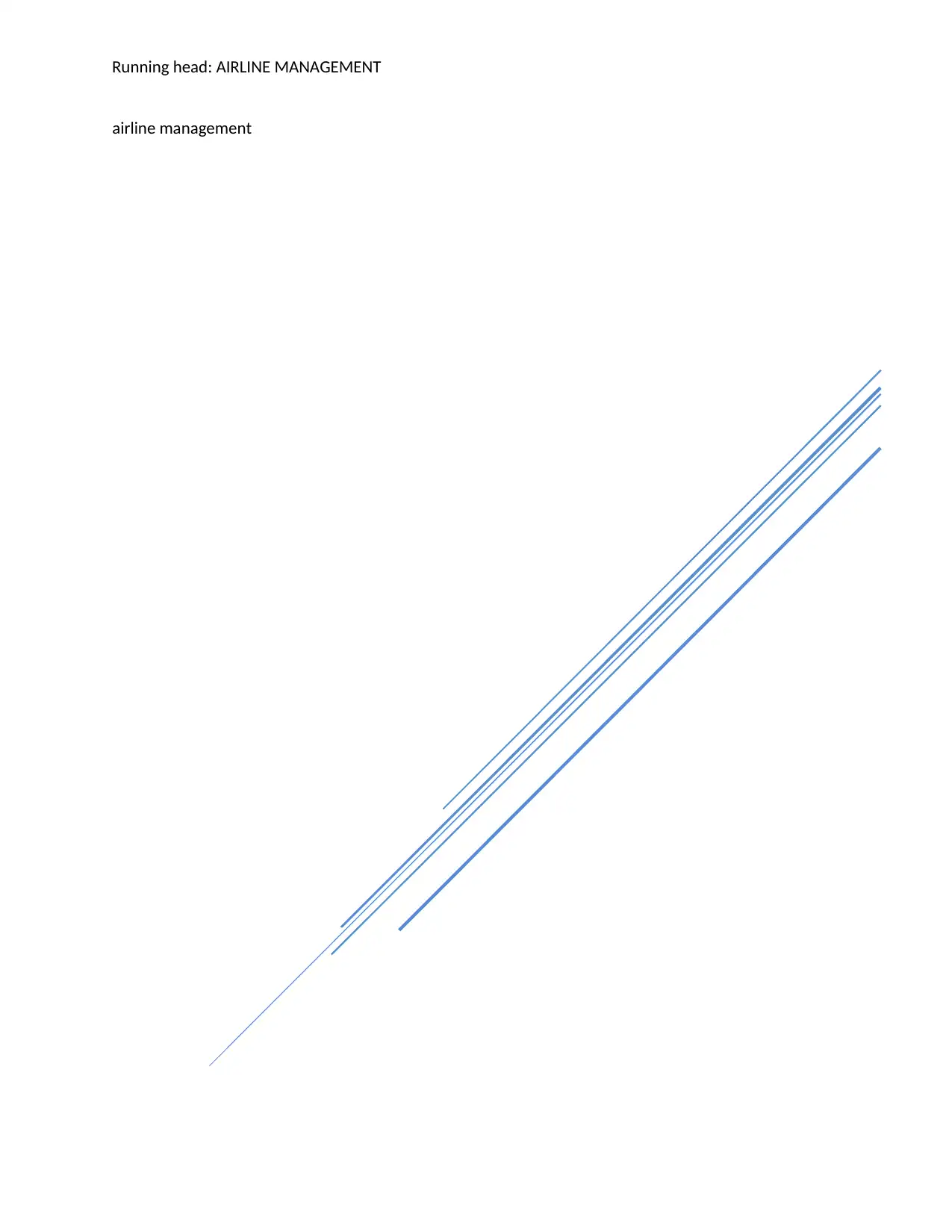
Running head: AIRLINE MANAGEMENT
airline management
airline management
Paraphrase This Document
Need a fresh take? Get an instant paraphrase of this document with our AI Paraphraser
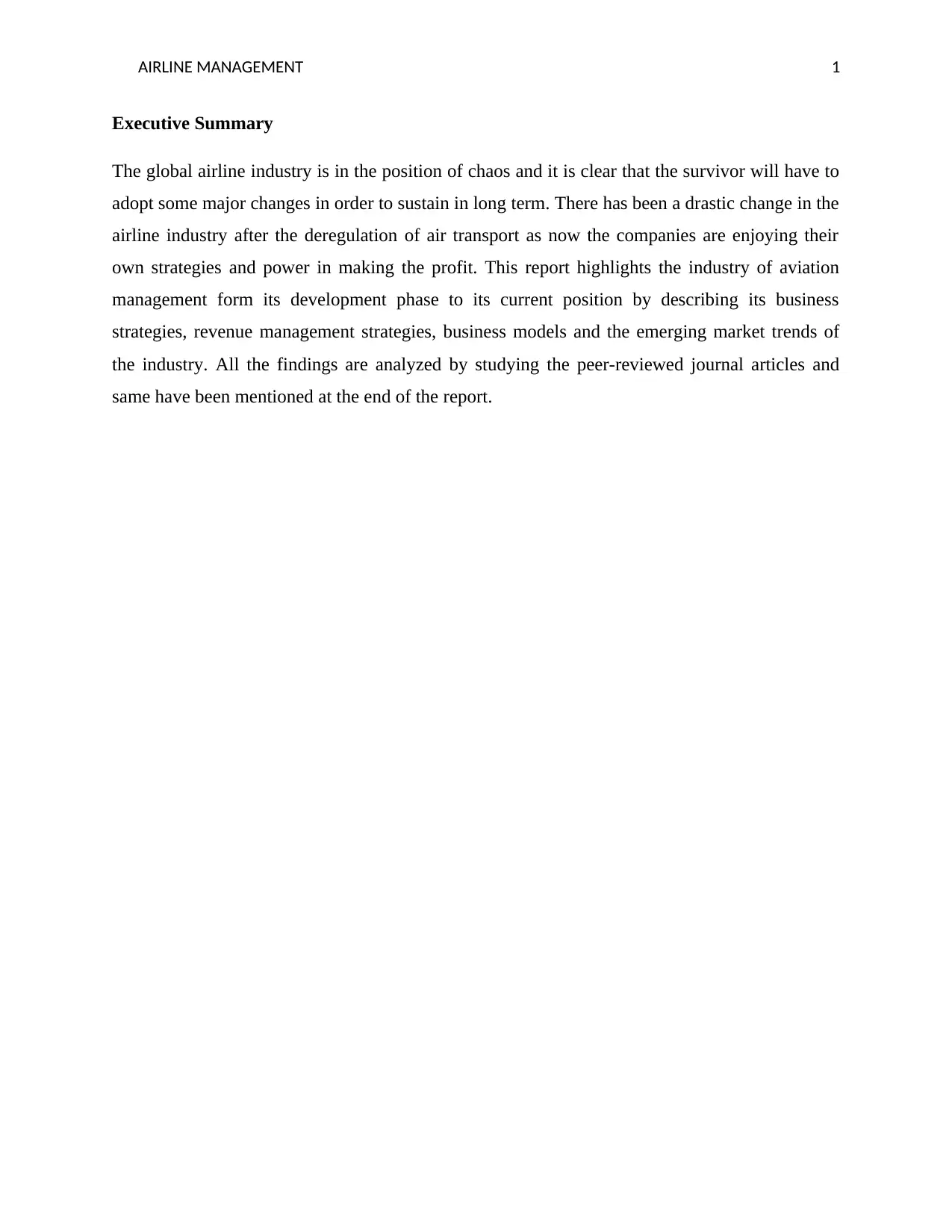
AIRLINE MANAGEMENT 1
Executive Summary
The global airline industry is in the position of chaos and it is clear that the survivor will have to
adopt some major changes in order to sustain in long term. There has been a drastic change in the
airline industry after the deregulation of air transport as now the companies are enjoying their
own strategies and power in making the profit. This report highlights the industry of aviation
management form its development phase to its current position by describing its business
strategies, revenue management strategies, business models and the emerging market trends of
the industry. All the findings are analyzed by studying the peer-reviewed journal articles and
same have been mentioned at the end of the report.
Executive Summary
The global airline industry is in the position of chaos and it is clear that the survivor will have to
adopt some major changes in order to sustain in long term. There has been a drastic change in the
airline industry after the deregulation of air transport as now the companies are enjoying their
own strategies and power in making the profit. This report highlights the industry of aviation
management form its development phase to its current position by describing its business
strategies, revenue management strategies, business models and the emerging market trends of
the industry. All the findings are analyzed by studying the peer-reviewed journal articles and
same have been mentioned at the end of the report.
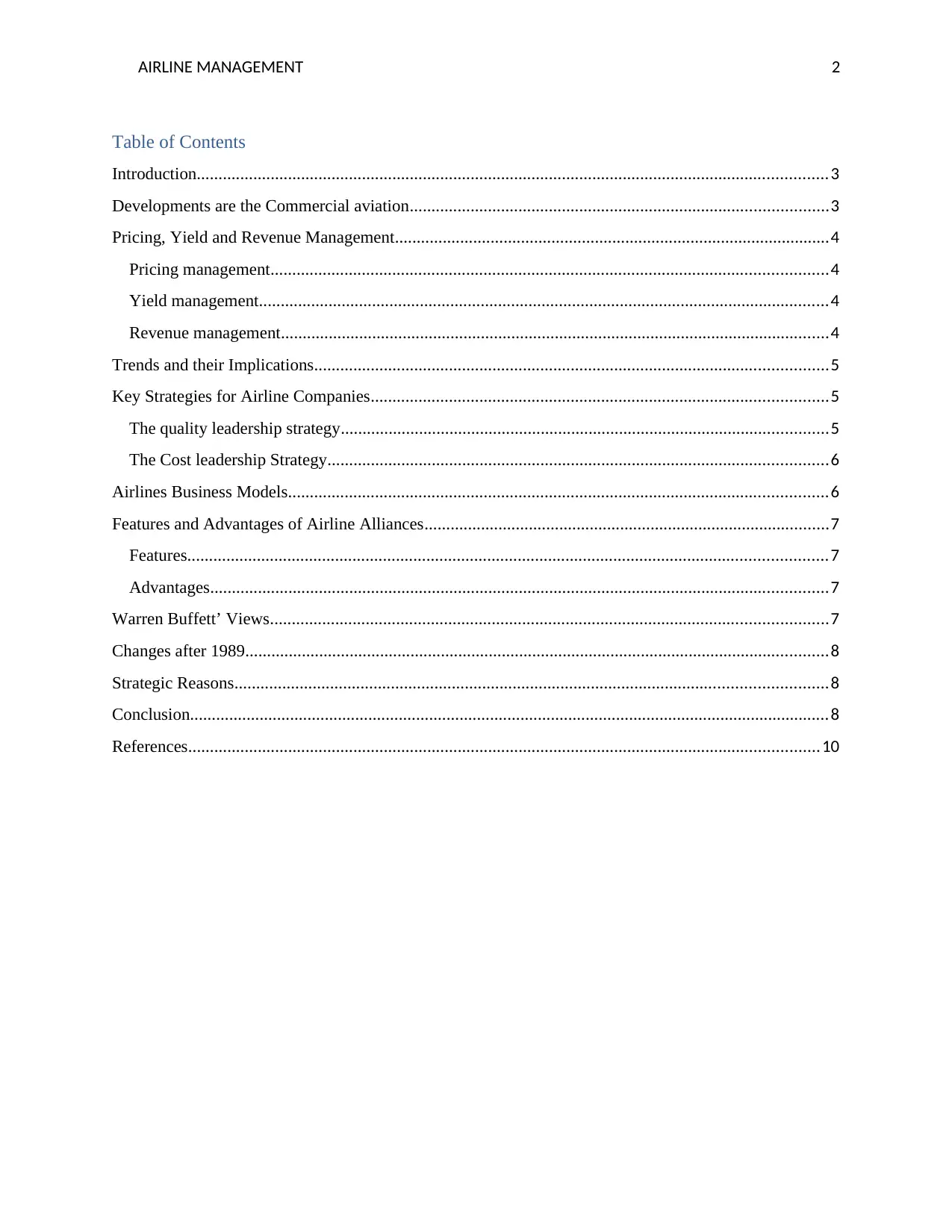
AIRLINE MANAGEMENT 2
Table of Contents
Introduction.................................................................................................................................................3
Developments are the Commercial aviation................................................................................................3
Pricing, Yield and Revenue Management....................................................................................................4
Pricing management................................................................................................................................4
Yield management...................................................................................................................................4
Revenue management..............................................................................................................................4
Trends and their Implications......................................................................................................................5
Key Strategies for Airline Companies.........................................................................................................5
The quality leadership strategy................................................................................................................5
The Cost leadership Strategy...................................................................................................................6
Airlines Business Models............................................................................................................................6
Features and Advantages of Airline Alliances.............................................................................................7
Features...................................................................................................................................................7
Advantages..............................................................................................................................................7
Warren Buffett’ Views................................................................................................................................7
Changes after 1989......................................................................................................................................8
Strategic Reasons........................................................................................................................................8
Conclusion...................................................................................................................................................8
References.................................................................................................................................................10
Table of Contents
Introduction.................................................................................................................................................3
Developments are the Commercial aviation................................................................................................3
Pricing, Yield and Revenue Management....................................................................................................4
Pricing management................................................................................................................................4
Yield management...................................................................................................................................4
Revenue management..............................................................................................................................4
Trends and their Implications......................................................................................................................5
Key Strategies for Airline Companies.........................................................................................................5
The quality leadership strategy................................................................................................................5
The Cost leadership Strategy...................................................................................................................6
Airlines Business Models............................................................................................................................6
Features and Advantages of Airline Alliances.............................................................................................7
Features...................................................................................................................................................7
Advantages..............................................................................................................................................7
Warren Buffett’ Views................................................................................................................................7
Changes after 1989......................................................................................................................................8
Strategic Reasons........................................................................................................................................8
Conclusion...................................................................................................................................................8
References.................................................................................................................................................10
⊘ This is a preview!⊘
Do you want full access?
Subscribe today to unlock all pages.

Trusted by 1+ million students worldwide
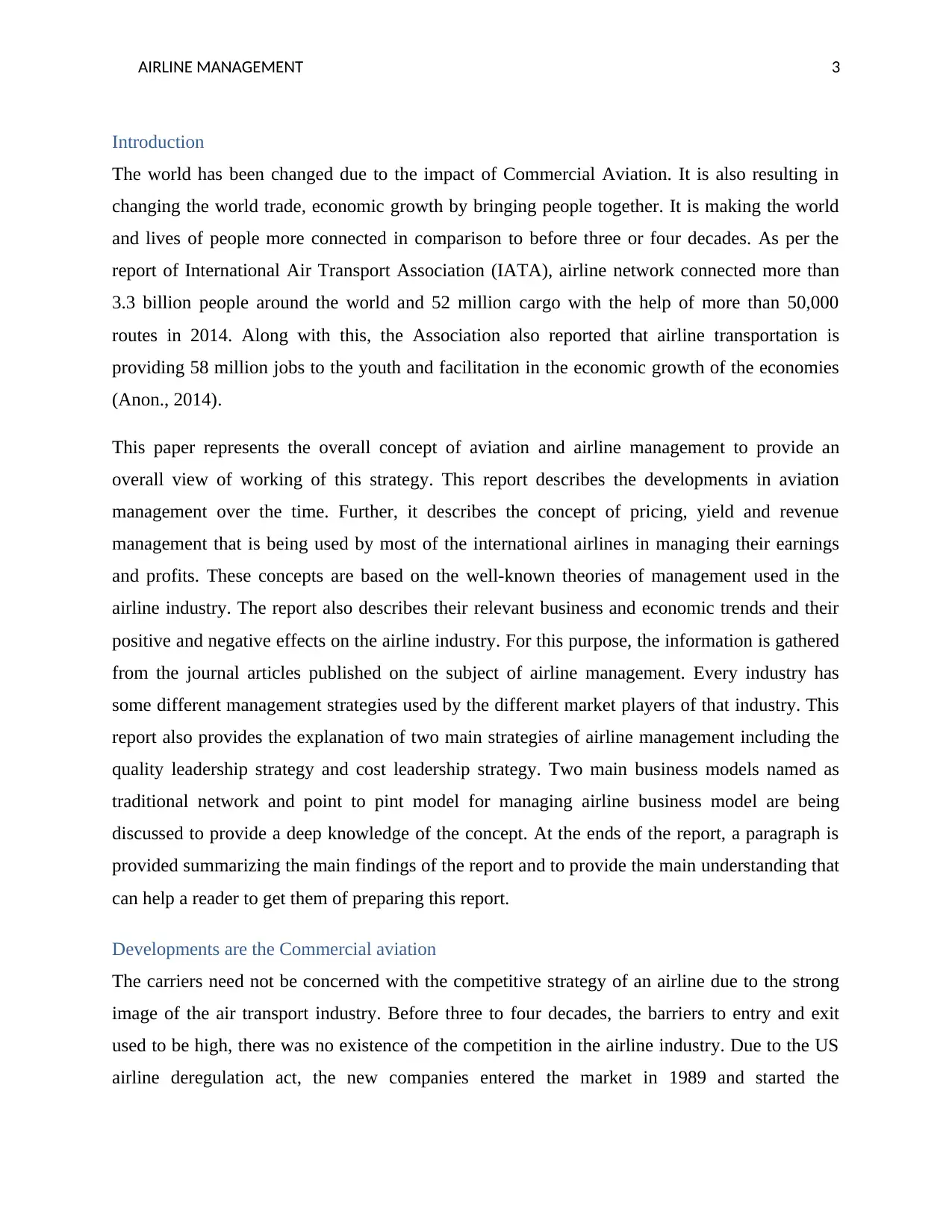
AIRLINE MANAGEMENT 3
Introduction
The world has been changed due to the impact of Commercial Aviation. It is also resulting in
changing the world trade, economic growth by bringing people together. It is making the world
and lives of people more connected in comparison to before three or four decades. As per the
report of International Air Transport Association (IATA), airline network connected more than
3.3 billion people around the world and 52 million cargo with the help of more than 50,000
routes in 2014. Along with this, the Association also reported that airline transportation is
providing 58 million jobs to the youth and facilitation in the economic growth of the economies
(Anon., 2014).
This paper represents the overall concept of aviation and airline management to provide an
overall view of working of this strategy. This report describes the developments in aviation
management over the time. Further, it describes the concept of pricing, yield and revenue
management that is being used by most of the international airlines in managing their earnings
and profits. These concepts are based on the well-known theories of management used in the
airline industry. The report also describes their relevant business and economic trends and their
positive and negative effects on the airline industry. For this purpose, the information is gathered
from the journal articles published on the subject of airline management. Every industry has
some different management strategies used by the different market players of that industry. This
report also provides the explanation of two main strategies of airline management including the
quality leadership strategy and cost leadership strategy. Two main business models named as
traditional network and point to pint model for managing airline business model are being
discussed to provide a deep knowledge of the concept. At the ends of the report, a paragraph is
provided summarizing the main findings of the report and to provide the main understanding that
can help a reader to get them of preparing this report.
Developments are the Commercial aviation
The carriers need not be concerned with the competitive strategy of an airline due to the strong
image of the air transport industry. Before three to four decades, the barriers to entry and exit
used to be high, there was no existence of the competition in the airline industry. Due to the US
airline deregulation act, the new companies entered the market in 1989 and started the
Introduction
The world has been changed due to the impact of Commercial Aviation. It is also resulting in
changing the world trade, economic growth by bringing people together. It is making the world
and lives of people more connected in comparison to before three or four decades. As per the
report of International Air Transport Association (IATA), airline network connected more than
3.3 billion people around the world and 52 million cargo with the help of more than 50,000
routes in 2014. Along with this, the Association also reported that airline transportation is
providing 58 million jobs to the youth and facilitation in the economic growth of the economies
(Anon., 2014).
This paper represents the overall concept of aviation and airline management to provide an
overall view of working of this strategy. This report describes the developments in aviation
management over the time. Further, it describes the concept of pricing, yield and revenue
management that is being used by most of the international airlines in managing their earnings
and profits. These concepts are based on the well-known theories of management used in the
airline industry. The report also describes their relevant business and economic trends and their
positive and negative effects on the airline industry. For this purpose, the information is gathered
from the journal articles published on the subject of airline management. Every industry has
some different management strategies used by the different market players of that industry. This
report also provides the explanation of two main strategies of airline management including the
quality leadership strategy and cost leadership strategy. Two main business models named as
traditional network and point to pint model for managing airline business model are being
discussed to provide a deep knowledge of the concept. At the ends of the report, a paragraph is
provided summarizing the main findings of the report and to provide the main understanding that
can help a reader to get them of preparing this report.
Developments are the Commercial aviation
The carriers need not be concerned with the competitive strategy of an airline due to the strong
image of the air transport industry. Before three to four decades, the barriers to entry and exit
used to be high, there was no existence of the competition in the airline industry. Due to the US
airline deregulation act, the new companies entered the market in 1989 and started the
Paraphrase This Document
Need a fresh take? Get an instant paraphrase of this document with our AI Paraphraser
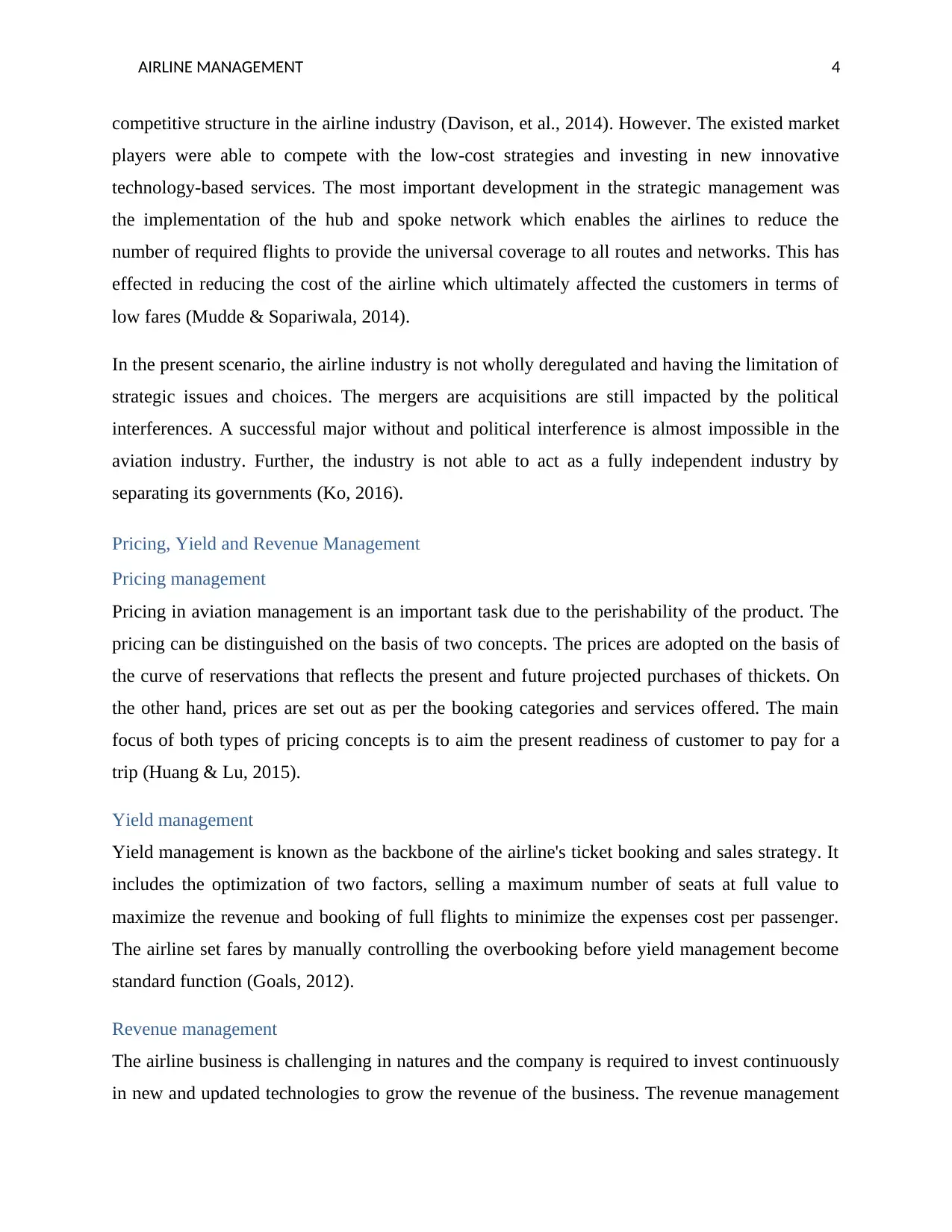
AIRLINE MANAGEMENT 4
competitive structure in the airline industry (Davison, et al., 2014). However. The existed market
players were able to compete with the low-cost strategies and investing in new innovative
technology-based services. The most important development in the strategic management was
the implementation of the hub and spoke network which enables the airlines to reduce the
number of required flights to provide the universal coverage to all routes and networks. This has
effected in reducing the cost of the airline which ultimately affected the customers in terms of
low fares (Mudde & Sopariwala, 2014).
In the present scenario, the airline industry is not wholly deregulated and having the limitation of
strategic issues and choices. The mergers are acquisitions are still impacted by the political
interferences. A successful major without and political interference is almost impossible in the
aviation industry. Further, the industry is not able to act as a fully independent industry by
separating its governments (Ko, 2016).
Pricing, Yield and Revenue Management
Pricing management
Pricing in aviation management is an important task due to the perishability of the product. The
pricing can be distinguished on the basis of two concepts. The prices are adopted on the basis of
the curve of reservations that reflects the present and future projected purchases of thickets. On
the other hand, prices are set out as per the booking categories and services offered. The main
focus of both types of pricing concepts is to aim the present readiness of customer to pay for a
trip (Huang & Lu, 2015).
Yield management
Yield management is known as the backbone of the airline's ticket booking and sales strategy. It
includes the optimization of two factors, selling a maximum number of seats at full value to
maximize the revenue and booking of full flights to minimize the expenses cost per passenger.
The airline set fares by manually controlling the overbooking before yield management become
standard function (Goals, 2012).
Revenue management
The airline business is challenging in natures and the company is required to invest continuously
in new and updated technologies to grow the revenue of the business. The revenue management
competitive structure in the airline industry (Davison, et al., 2014). However. The existed market
players were able to compete with the low-cost strategies and investing in new innovative
technology-based services. The most important development in the strategic management was
the implementation of the hub and spoke network which enables the airlines to reduce the
number of required flights to provide the universal coverage to all routes and networks. This has
effected in reducing the cost of the airline which ultimately affected the customers in terms of
low fares (Mudde & Sopariwala, 2014).
In the present scenario, the airline industry is not wholly deregulated and having the limitation of
strategic issues and choices. The mergers are acquisitions are still impacted by the political
interferences. A successful major without and political interference is almost impossible in the
aviation industry. Further, the industry is not able to act as a fully independent industry by
separating its governments (Ko, 2016).
Pricing, Yield and Revenue Management
Pricing management
Pricing in aviation management is an important task due to the perishability of the product. The
pricing can be distinguished on the basis of two concepts. The prices are adopted on the basis of
the curve of reservations that reflects the present and future projected purchases of thickets. On
the other hand, prices are set out as per the booking categories and services offered. The main
focus of both types of pricing concepts is to aim the present readiness of customer to pay for a
trip (Huang & Lu, 2015).
Yield management
Yield management is known as the backbone of the airline's ticket booking and sales strategy. It
includes the optimization of two factors, selling a maximum number of seats at full value to
maximize the revenue and booking of full flights to minimize the expenses cost per passenger.
The airline set fares by manually controlling the overbooking before yield management become
standard function (Goals, 2012).
Revenue management
The airline business is challenging in natures and the company is required to invest continuously
in new and updated technologies to grow the revenue of the business. The revenue management
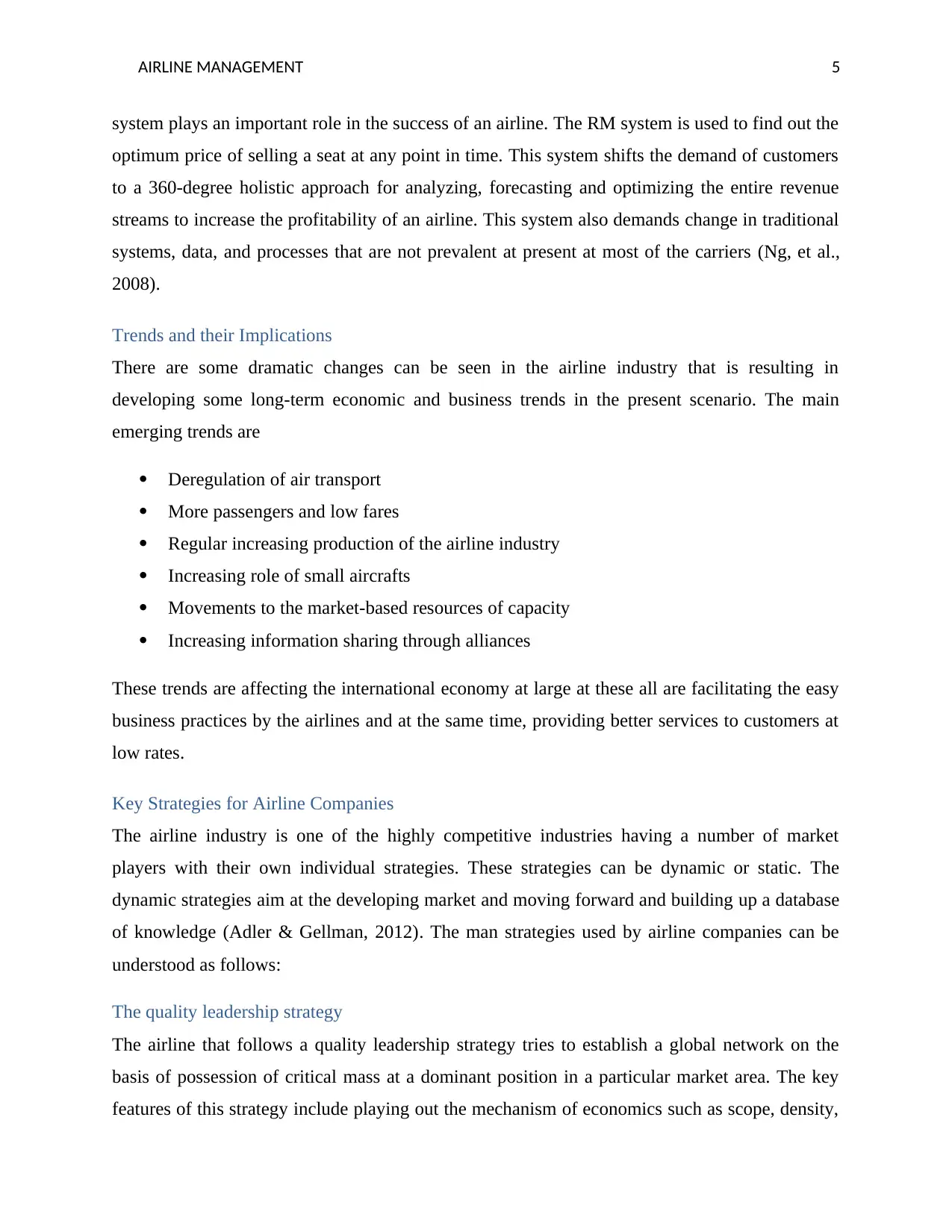
AIRLINE MANAGEMENT 5
system plays an important role in the success of an airline. The RM system is used to find out the
optimum price of selling a seat at any point in time. This system shifts the demand of customers
to a 360-degree holistic approach for analyzing, forecasting and optimizing the entire revenue
streams to increase the profitability of an airline. This system also demands change in traditional
systems, data, and processes that are not prevalent at present at most of the carriers (Ng, et al.,
2008).
Trends and their Implications
There are some dramatic changes can be seen in the airline industry that is resulting in
developing some long-term economic and business trends in the present scenario. The main
emerging trends are
Deregulation of air transport
More passengers and low fares
Regular increasing production of the airline industry
Increasing role of small aircrafts
Movements to the market-based resources of capacity
Increasing information sharing through alliances
These trends are affecting the international economy at large at these all are facilitating the easy
business practices by the airlines and at the same time, providing better services to customers at
low rates.
Key Strategies for Airline Companies
The airline industry is one of the highly competitive industries having a number of market
players with their own individual strategies. These strategies can be dynamic or static. The
dynamic strategies aim at the developing market and moving forward and building up a database
of knowledge (Adler & Gellman, 2012). The man strategies used by airline companies can be
understood as follows:
The quality leadership strategy
The airline that follows a quality leadership strategy tries to establish a global network on the
basis of possession of critical mass at a dominant position in a particular market area. The key
features of this strategy include playing out the mechanism of economics such as scope, density,
system plays an important role in the success of an airline. The RM system is used to find out the
optimum price of selling a seat at any point in time. This system shifts the demand of customers
to a 360-degree holistic approach for analyzing, forecasting and optimizing the entire revenue
streams to increase the profitability of an airline. This system also demands change in traditional
systems, data, and processes that are not prevalent at present at most of the carriers (Ng, et al.,
2008).
Trends and their Implications
There are some dramatic changes can be seen in the airline industry that is resulting in
developing some long-term economic and business trends in the present scenario. The main
emerging trends are
Deregulation of air transport
More passengers and low fares
Regular increasing production of the airline industry
Increasing role of small aircrafts
Movements to the market-based resources of capacity
Increasing information sharing through alliances
These trends are affecting the international economy at large at these all are facilitating the easy
business practices by the airlines and at the same time, providing better services to customers at
low rates.
Key Strategies for Airline Companies
The airline industry is one of the highly competitive industries having a number of market
players with their own individual strategies. These strategies can be dynamic or static. The
dynamic strategies aim at the developing market and moving forward and building up a database
of knowledge (Adler & Gellman, 2012). The man strategies used by airline companies can be
understood as follows:
The quality leadership strategy
The airline that follows a quality leadership strategy tries to establish a global network on the
basis of possession of critical mass at a dominant position in a particular market area. The key
features of this strategy include playing out the mechanism of economics such as scope, density,
⊘ This is a preview!⊘
Do you want full access?
Subscribe today to unlock all pages.

Trusted by 1+ million students worldwide
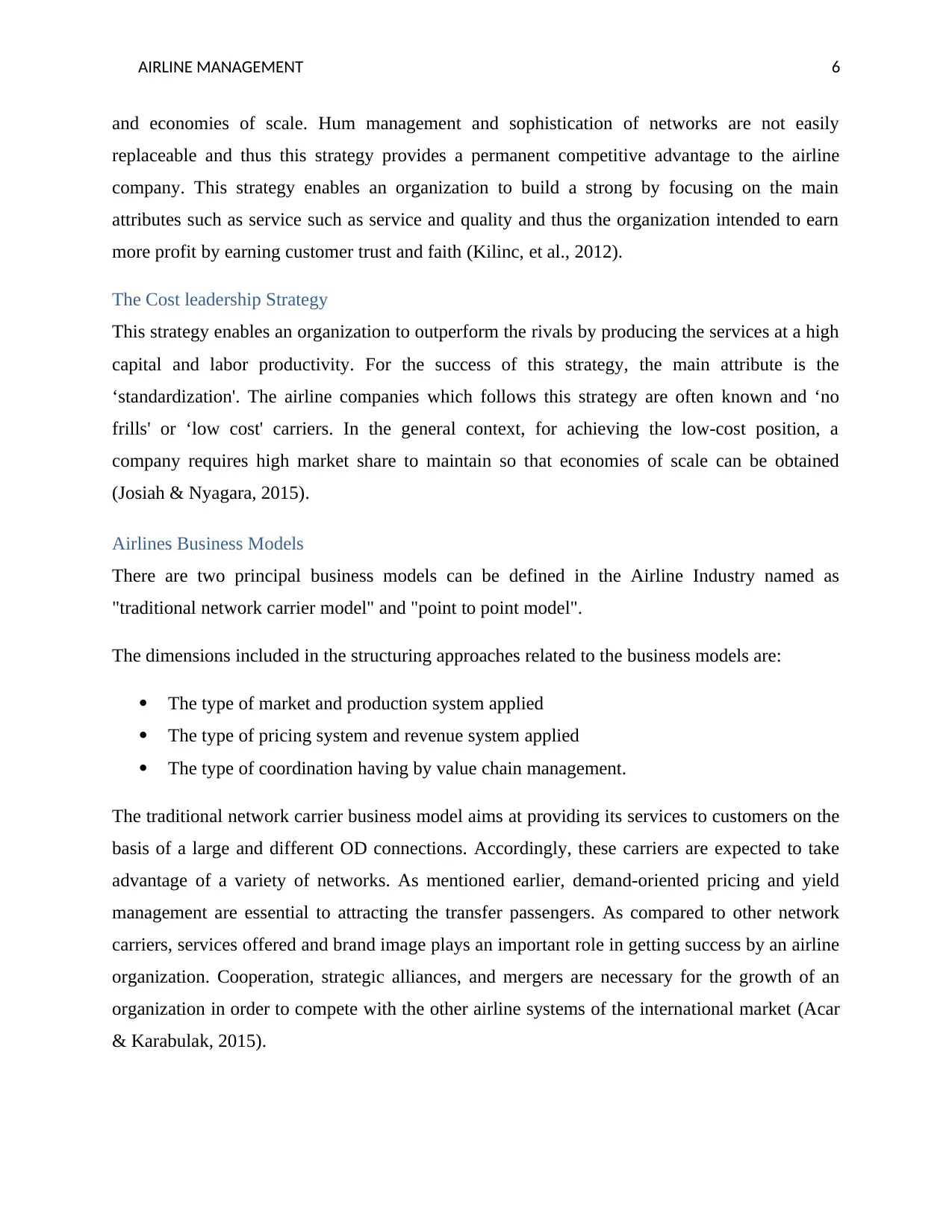
AIRLINE MANAGEMENT 6
and economies of scale. Hum management and sophistication of networks are not easily
replaceable and thus this strategy provides a permanent competitive advantage to the airline
company. This strategy enables an organization to build a strong by focusing on the main
attributes such as service such as service and quality and thus the organization intended to earn
more profit by earning customer trust and faith (Kilinc, et al., 2012).
The Cost leadership Strategy
This strategy enables an organization to outperform the rivals by producing the services at a high
capital and labor productivity. For the success of this strategy, the main attribute is the
‘standardization'. The airline companies which follows this strategy are often known and ‘no
frills' or ‘low cost' carriers. In the general context, for achieving the low-cost position, a
company requires high market share to maintain so that economies of scale can be obtained
(Josiah & Nyagara, 2015).
Airlines Business Models
There are two principal business models can be defined in the Airline Industry named as
"traditional network carrier model" and "point to point model".
The dimensions included in the structuring approaches related to the business models are:
The type of market and production system applied
The type of pricing system and revenue system applied
The type of coordination having by value chain management.
The traditional network carrier business model aims at providing its services to customers on the
basis of a large and different OD connections. Accordingly, these carriers are expected to take
advantage of a variety of networks. As mentioned earlier, demand-oriented pricing and yield
management are essential to attracting the transfer passengers. As compared to other network
carriers, services offered and brand image plays an important role in getting success by an airline
organization. Cooperation, strategic alliances, and mergers are necessary for the growth of an
organization in order to compete with the other airline systems of the international market (Acar
& Karabulak, 2015).
and economies of scale. Hum management and sophistication of networks are not easily
replaceable and thus this strategy provides a permanent competitive advantage to the airline
company. This strategy enables an organization to build a strong by focusing on the main
attributes such as service such as service and quality and thus the organization intended to earn
more profit by earning customer trust and faith (Kilinc, et al., 2012).
The Cost leadership Strategy
This strategy enables an organization to outperform the rivals by producing the services at a high
capital and labor productivity. For the success of this strategy, the main attribute is the
‘standardization'. The airline companies which follows this strategy are often known and ‘no
frills' or ‘low cost' carriers. In the general context, for achieving the low-cost position, a
company requires high market share to maintain so that economies of scale can be obtained
(Josiah & Nyagara, 2015).
Airlines Business Models
There are two principal business models can be defined in the Airline Industry named as
"traditional network carrier model" and "point to point model".
The dimensions included in the structuring approaches related to the business models are:
The type of market and production system applied
The type of pricing system and revenue system applied
The type of coordination having by value chain management.
The traditional network carrier business model aims at providing its services to customers on the
basis of a large and different OD connections. Accordingly, these carriers are expected to take
advantage of a variety of networks. As mentioned earlier, demand-oriented pricing and yield
management are essential to attracting the transfer passengers. As compared to other network
carriers, services offered and brand image plays an important role in getting success by an airline
organization. Cooperation, strategic alliances, and mergers are necessary for the growth of an
organization in order to compete with the other airline systems of the international market (Acar
& Karabulak, 2015).
Paraphrase This Document
Need a fresh take? Get an instant paraphrase of this document with our AI Paraphraser
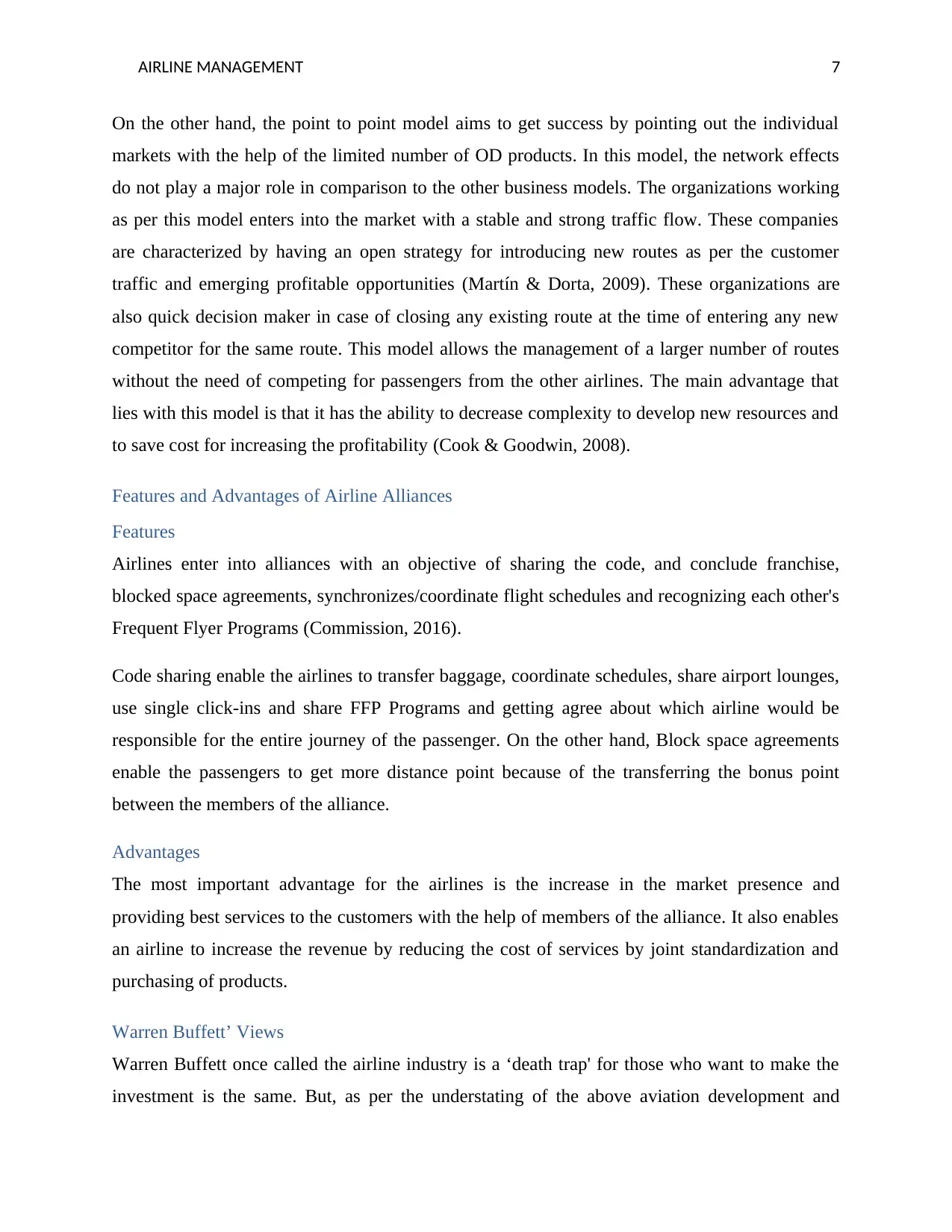
AIRLINE MANAGEMENT 7
On the other hand, the point to point model aims to get success by pointing out the individual
markets with the help of the limited number of OD products. In this model, the network effects
do not play a major role in comparison to the other business models. The organizations working
as per this model enters into the market with a stable and strong traffic flow. These companies
are characterized by having an open strategy for introducing new routes as per the customer
traffic and emerging profitable opportunities (Martín & Dorta, 2009). These organizations are
also quick decision maker in case of closing any existing route at the time of entering any new
competitor for the same route. This model allows the management of a larger number of routes
without the need of competing for passengers from the other airlines. The main advantage that
lies with this model is that it has the ability to decrease complexity to develop new resources and
to save cost for increasing the profitability (Cook & Goodwin, 2008).
Features and Advantages of Airline Alliances
Features
Airlines enter into alliances with an objective of sharing the code, and conclude franchise,
blocked space agreements, synchronizes/coordinate flight schedules and recognizing each other's
Frequent Flyer Programs (Commission, 2016).
Code sharing enable the airlines to transfer baggage, coordinate schedules, share airport lounges,
use single click-ins and share FFP Programs and getting agree about which airline would be
responsible for the entire journey of the passenger. On the other hand, Block space agreements
enable the passengers to get more distance point because of the transferring the bonus point
between the members of the alliance.
Advantages
The most important advantage for the airlines is the increase in the market presence and
providing best services to the customers with the help of members of the alliance. It also enables
an airline to increase the revenue by reducing the cost of services by joint standardization and
purchasing of products.
Warren Buffett’ Views
Warren Buffett once called the airline industry is a ‘death trap' for those who want to make the
investment is the same. But, as per the understating of the above aviation development and
On the other hand, the point to point model aims to get success by pointing out the individual
markets with the help of the limited number of OD products. In this model, the network effects
do not play a major role in comparison to the other business models. The organizations working
as per this model enters into the market with a stable and strong traffic flow. These companies
are characterized by having an open strategy for introducing new routes as per the customer
traffic and emerging profitable opportunities (Martín & Dorta, 2009). These organizations are
also quick decision maker in case of closing any existing route at the time of entering any new
competitor for the same route. This model allows the management of a larger number of routes
without the need of competing for passengers from the other airlines. The main advantage that
lies with this model is that it has the ability to decrease complexity to develop new resources and
to save cost for increasing the profitability (Cook & Goodwin, 2008).
Features and Advantages of Airline Alliances
Features
Airlines enter into alliances with an objective of sharing the code, and conclude franchise,
blocked space agreements, synchronizes/coordinate flight schedules and recognizing each other's
Frequent Flyer Programs (Commission, 2016).
Code sharing enable the airlines to transfer baggage, coordinate schedules, share airport lounges,
use single click-ins and share FFP Programs and getting agree about which airline would be
responsible for the entire journey of the passenger. On the other hand, Block space agreements
enable the passengers to get more distance point because of the transferring the bonus point
between the members of the alliance.
Advantages
The most important advantage for the airlines is the increase in the market presence and
providing best services to the customers with the help of members of the alliance. It also enables
an airline to increase the revenue by reducing the cost of services by joint standardization and
purchasing of products.
Warren Buffett’ Views
Warren Buffett once called the airline industry is a ‘death trap' for those who want to make the
investment is the same. But, as per the understating of the above aviation development and
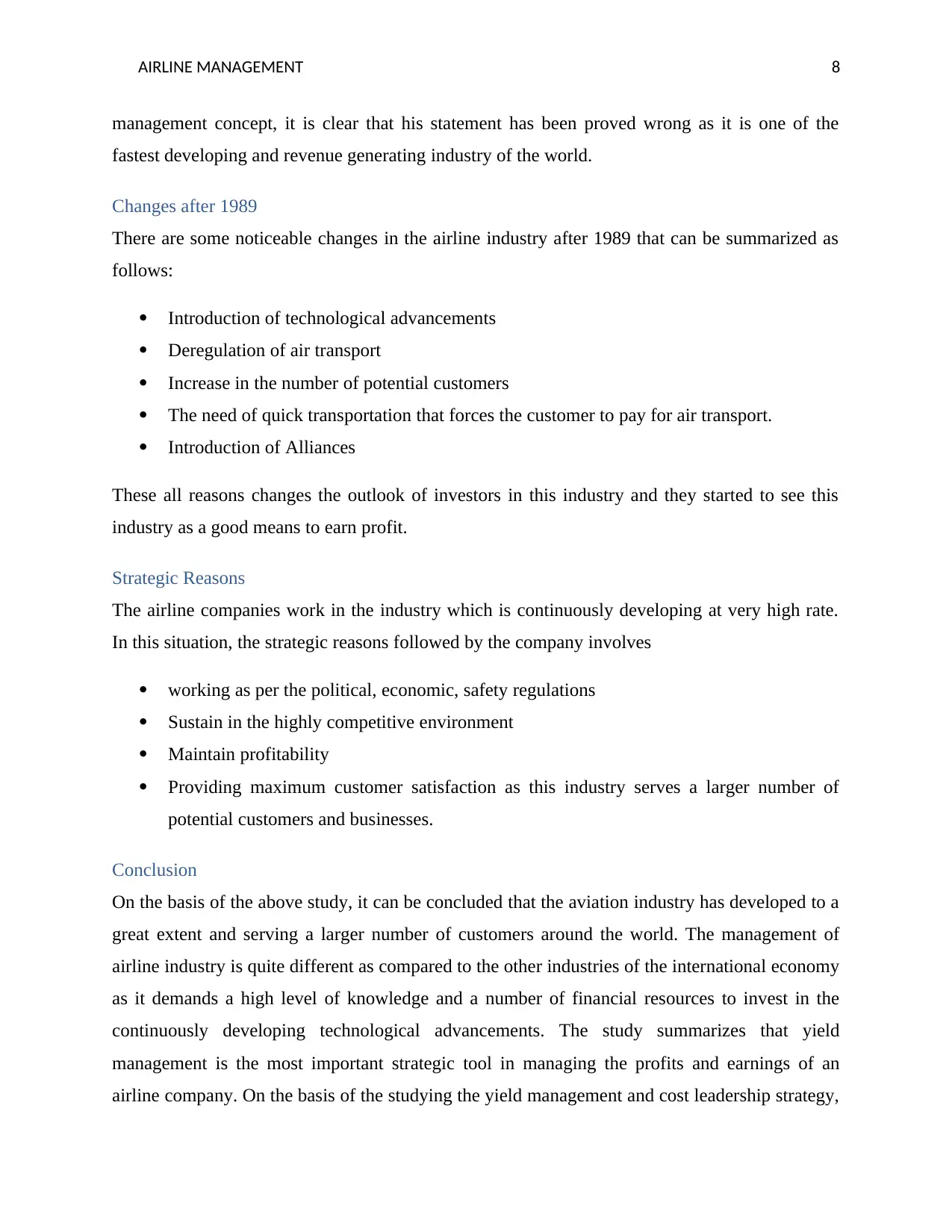
AIRLINE MANAGEMENT 8
management concept, it is clear that his statement has been proved wrong as it is one of the
fastest developing and revenue generating industry of the world.
Changes after 1989
There are some noticeable changes in the airline industry after 1989 that can be summarized as
follows:
Introduction of technological advancements
Deregulation of air transport
Increase in the number of potential customers
The need of quick transportation that forces the customer to pay for air transport.
Introduction of Alliances
These all reasons changes the outlook of investors in this industry and they started to see this
industry as a good means to earn profit.
Strategic Reasons
The airline companies work in the industry which is continuously developing at very high rate.
In this situation, the strategic reasons followed by the company involves
working as per the political, economic, safety regulations
Sustain in the highly competitive environment
Maintain profitability
Providing maximum customer satisfaction as this industry serves a larger number of
potential customers and businesses.
Conclusion
On the basis of the above study, it can be concluded that the aviation industry has developed to a
great extent and serving a larger number of customers around the world. The management of
airline industry is quite different as compared to the other industries of the international economy
as it demands a high level of knowledge and a number of financial resources to invest in the
continuously developing technological advancements. The study summarizes that yield
management is the most important strategic tool in managing the profits and earnings of an
airline company. On the basis of the studying the yield management and cost leadership strategy,
management concept, it is clear that his statement has been proved wrong as it is one of the
fastest developing and revenue generating industry of the world.
Changes after 1989
There are some noticeable changes in the airline industry after 1989 that can be summarized as
follows:
Introduction of technological advancements
Deregulation of air transport
Increase in the number of potential customers
The need of quick transportation that forces the customer to pay for air transport.
Introduction of Alliances
These all reasons changes the outlook of investors in this industry and they started to see this
industry as a good means to earn profit.
Strategic Reasons
The airline companies work in the industry which is continuously developing at very high rate.
In this situation, the strategic reasons followed by the company involves
working as per the political, economic, safety regulations
Sustain in the highly competitive environment
Maintain profitability
Providing maximum customer satisfaction as this industry serves a larger number of
potential customers and businesses.
Conclusion
On the basis of the above study, it can be concluded that the aviation industry has developed to a
great extent and serving a larger number of customers around the world. The management of
airline industry is quite different as compared to the other industries of the international economy
as it demands a high level of knowledge and a number of financial resources to invest in the
continuously developing technological advancements. The study summarizes that yield
management is the most important strategic tool in managing the profits and earnings of an
airline company. On the basis of the studying the yield management and cost leadership strategy,
⊘ This is a preview!⊘
Do you want full access?
Subscribe today to unlock all pages.

Trusted by 1+ million students worldwide
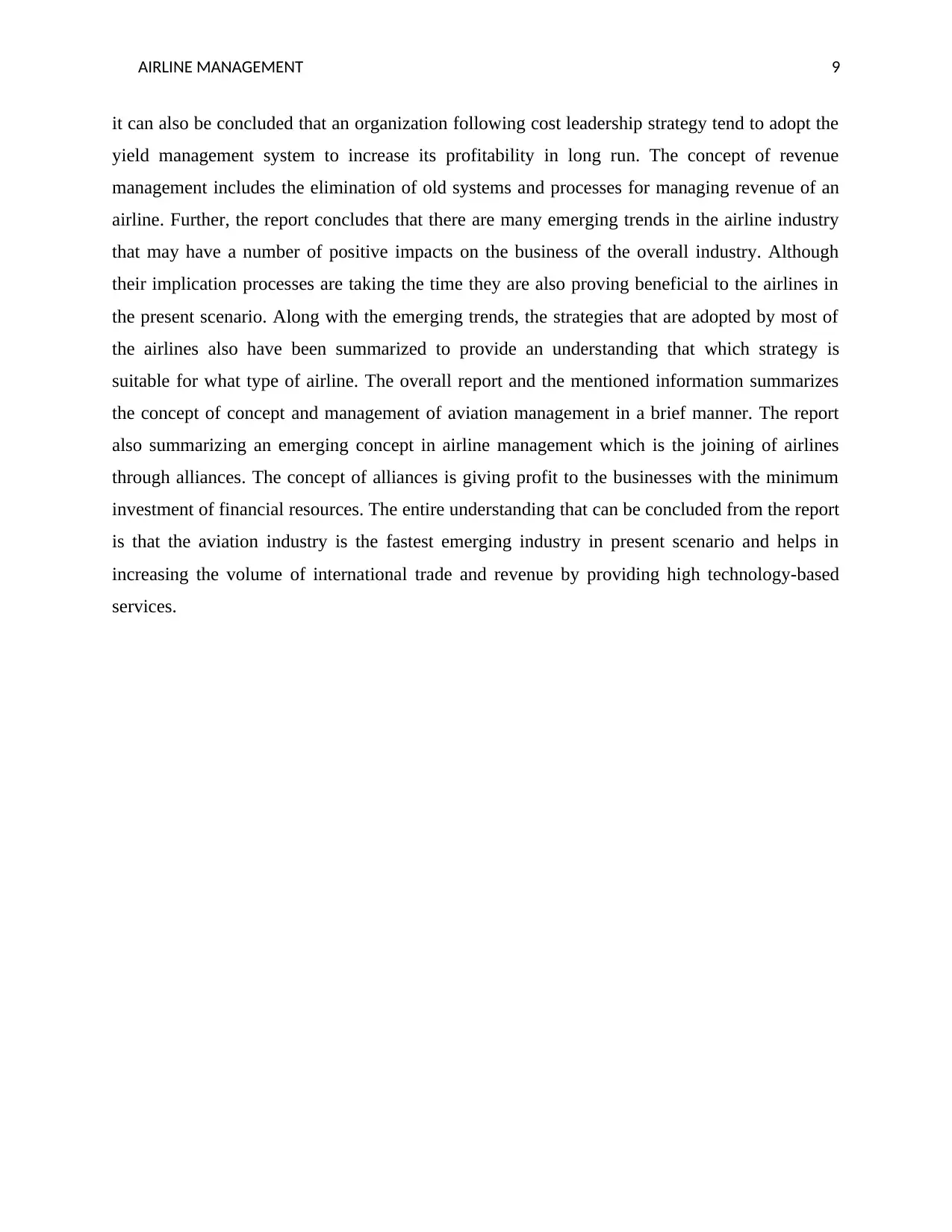
AIRLINE MANAGEMENT 9
it can also be concluded that an organization following cost leadership strategy tend to adopt the
yield management system to increase its profitability in long run. The concept of revenue
management includes the elimination of old systems and processes for managing revenue of an
airline. Further, the report concludes that there are many emerging trends in the airline industry
that may have a number of positive impacts on the business of the overall industry. Although
their implication processes are taking the time they are also proving beneficial to the airlines in
the present scenario. Along with the emerging trends, the strategies that are adopted by most of
the airlines also have been summarized to provide an understanding that which strategy is
suitable for what type of airline. The overall report and the mentioned information summarizes
the concept of concept and management of aviation management in a brief manner. The report
also summarizing an emerging concept in airline management which is the joining of airlines
through alliances. The concept of alliances is giving profit to the businesses with the minimum
investment of financial resources. The entire understanding that can be concluded from the report
is that the aviation industry is the fastest emerging industry in present scenario and helps in
increasing the volume of international trade and revenue by providing high technology-based
services.
it can also be concluded that an organization following cost leadership strategy tend to adopt the
yield management system to increase its profitability in long run. The concept of revenue
management includes the elimination of old systems and processes for managing revenue of an
airline. Further, the report concludes that there are many emerging trends in the airline industry
that may have a number of positive impacts on the business of the overall industry. Although
their implication processes are taking the time they are also proving beneficial to the airlines in
the present scenario. Along with the emerging trends, the strategies that are adopted by most of
the airlines also have been summarized to provide an understanding that which strategy is
suitable for what type of airline. The overall report and the mentioned information summarizes
the concept of concept and management of aviation management in a brief manner. The report
also summarizing an emerging concept in airline management which is the joining of airlines
through alliances. The concept of alliances is giving profit to the businesses with the minimum
investment of financial resources. The entire understanding that can be concluded from the report
is that the aviation industry is the fastest emerging industry in present scenario and helps in
increasing the volume of international trade and revenue by providing high technology-based
services.
Paraphrase This Document
Need a fresh take? Get an instant paraphrase of this document with our AI Paraphraser
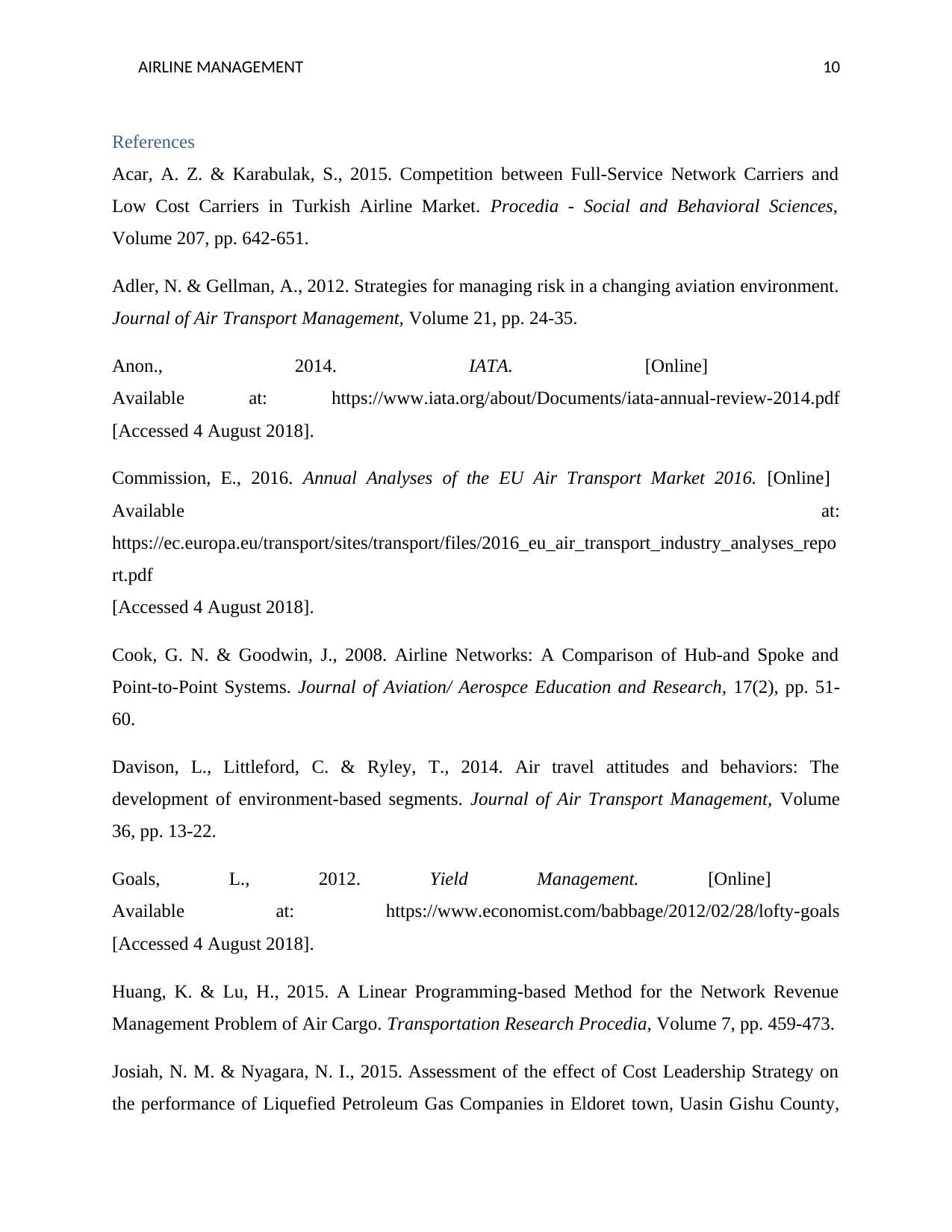
AIRLINE MANAGEMENT 10
References
Acar, A. Z. & Karabulak, S., 2015. Competition between Full-Service Network Carriers and
Low Cost Carriers in Turkish Airline Market. Procedia - Social and Behavioral Sciences,
Volume 207, pp. 642-651.
Adler, N. & Gellman, A., 2012. Strategies for managing risk in a changing aviation environment.
Journal of Air Transport Management, Volume 21, pp. 24-35.
Anon., 2014. IATA. [Online]
Available at: https://www.iata.org/about/Documents/iata-annual-review-2014.pdf
[Accessed 4 August 2018].
Commission, E., 2016. Annual Analyses of the EU Air Transport Market 2016. [Online]
Available at:
https://ec.europa.eu/transport/sites/transport/files/2016_eu_air_transport_industry_analyses_repo
rt.pdf
[Accessed 4 August 2018].
Cook, G. N. & Goodwin, J., 2008. Airline Networks: A Comparison of Hub-and Spoke and
Point-to-Point Systems. Journal of Aviation/ Aerospce Education and Research, 17(2), pp. 51-
60.
Davison, L., Littleford, C. & Ryley, T., 2014. Air travel attitudes and behaviors: The
development of environment-based segments. Journal of Air Transport Management, Volume
36, pp. 13-22.
Goals, L., 2012. Yield Management. [Online]
Available at: https://www.economist.com/babbage/2012/02/28/lofty-goals
[Accessed 4 August 2018].
Huang, K. & Lu, H., 2015. A Linear Programming-based Method for the Network Revenue
Management Problem of Air Cargo. Transportation Research Procedia, Volume 7, pp. 459-473.
Josiah, N. M. & Nyagara, N. I., 2015. Assessment of the effect of Cost Leadership Strategy on
the performance of Liquefied Petroleum Gas Companies in Eldoret town, Uasin Gishu County,
References
Acar, A. Z. & Karabulak, S., 2015. Competition between Full-Service Network Carriers and
Low Cost Carriers in Turkish Airline Market. Procedia - Social and Behavioral Sciences,
Volume 207, pp. 642-651.
Adler, N. & Gellman, A., 2012. Strategies for managing risk in a changing aviation environment.
Journal of Air Transport Management, Volume 21, pp. 24-35.
Anon., 2014. IATA. [Online]
Available at: https://www.iata.org/about/Documents/iata-annual-review-2014.pdf
[Accessed 4 August 2018].
Commission, E., 2016. Annual Analyses of the EU Air Transport Market 2016. [Online]
Available at:
https://ec.europa.eu/transport/sites/transport/files/2016_eu_air_transport_industry_analyses_repo
rt.pdf
[Accessed 4 August 2018].
Cook, G. N. & Goodwin, J., 2008. Airline Networks: A Comparison of Hub-and Spoke and
Point-to-Point Systems. Journal of Aviation/ Aerospce Education and Research, 17(2), pp. 51-
60.
Davison, L., Littleford, C. & Ryley, T., 2014. Air travel attitudes and behaviors: The
development of environment-based segments. Journal of Air Transport Management, Volume
36, pp. 13-22.
Goals, L., 2012. Yield Management. [Online]
Available at: https://www.economist.com/babbage/2012/02/28/lofty-goals
[Accessed 4 August 2018].
Huang, K. & Lu, H., 2015. A Linear Programming-based Method for the Network Revenue
Management Problem of Air Cargo. Transportation Research Procedia, Volume 7, pp. 459-473.
Josiah, N. M. & Nyagara, N. I., 2015. Assessment of the effect of Cost Leadership Strategy on
the performance of Liquefied Petroleum Gas Companies in Eldoret town, Uasin Gishu County,
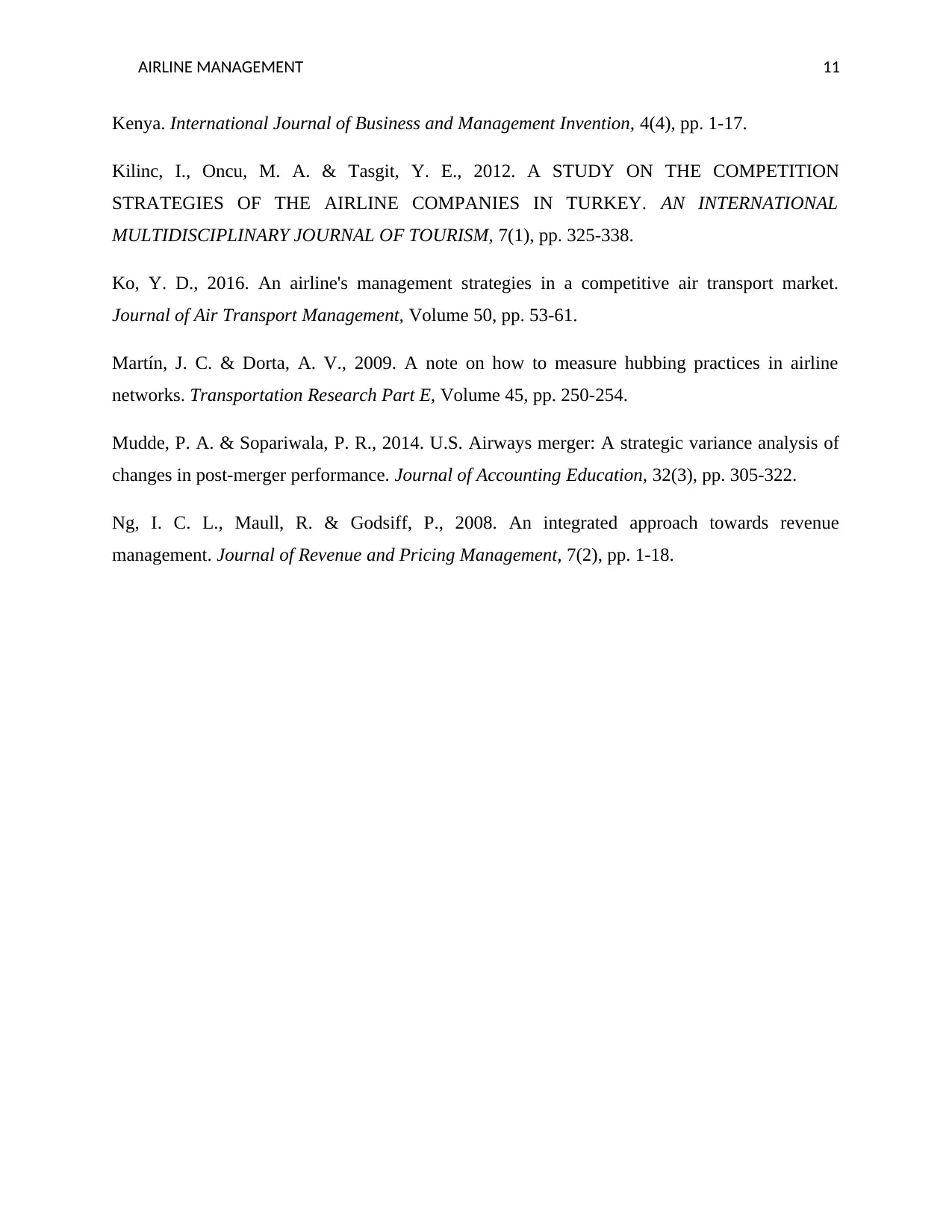
AIRLINE MANAGEMENT 11
Kenya. International Journal of Business and Management Invention, 4(4), pp. 1-17.
Kilinc, I., Oncu, M. A. & Tasgit, Y. E., 2012. A STUDY ON THE COMPETITION
STRATEGIES OF THE AIRLINE COMPANIES IN TURKEY. AN INTERNATIONAL
MULTIDISCIPLINARY JOURNAL OF TOURISM, 7(1), pp. 325-338.
Ko, Y. D., 2016. An airline's management strategies in a competitive air transport market.
Journal of Air Transport Management, Volume 50, pp. 53-61.
Martín, J. C. & Dorta, A. V., 2009. A note on how to measure hubbing practices in airline
networks. Transportation Research Part E, Volume 45, pp. 250-254.
Mudde, P. A. & Sopariwala, P. R., 2014. U.S. Airways merger: A strategic variance analysis of
changes in post-merger performance. Journal of Accounting Education, 32(3), pp. 305-322.
Ng, I. C. L., Maull, R. & Godsiff, P., 2008. An integrated approach towards revenue
management. Journal of Revenue and Pricing Management, 7(2), pp. 1-18.
Kenya. International Journal of Business and Management Invention, 4(4), pp. 1-17.
Kilinc, I., Oncu, M. A. & Tasgit, Y. E., 2012. A STUDY ON THE COMPETITION
STRATEGIES OF THE AIRLINE COMPANIES IN TURKEY. AN INTERNATIONAL
MULTIDISCIPLINARY JOURNAL OF TOURISM, 7(1), pp. 325-338.
Ko, Y. D., 2016. An airline's management strategies in a competitive air transport market.
Journal of Air Transport Management, Volume 50, pp. 53-61.
Martín, J. C. & Dorta, A. V., 2009. A note on how to measure hubbing practices in airline
networks. Transportation Research Part E, Volume 45, pp. 250-254.
Mudde, P. A. & Sopariwala, P. R., 2014. U.S. Airways merger: A strategic variance analysis of
changes in post-merger performance. Journal of Accounting Education, 32(3), pp. 305-322.
Ng, I. C. L., Maull, R. & Godsiff, P., 2008. An integrated approach towards revenue
management. Journal of Revenue and Pricing Management, 7(2), pp. 1-18.
⊘ This is a preview!⊘
Do you want full access?
Subscribe today to unlock all pages.

Trusted by 1+ million students worldwide
1 out of 12
Related Documents
Your All-in-One AI-Powered Toolkit for Academic Success.
+13062052269
info@desklib.com
Available 24*7 on WhatsApp / Email
![[object Object]](/_next/static/media/star-bottom.7253800d.svg)
Unlock your academic potential
Copyright © 2020–2025 A2Z Services. All Rights Reserved. Developed and managed by ZUCOL.




